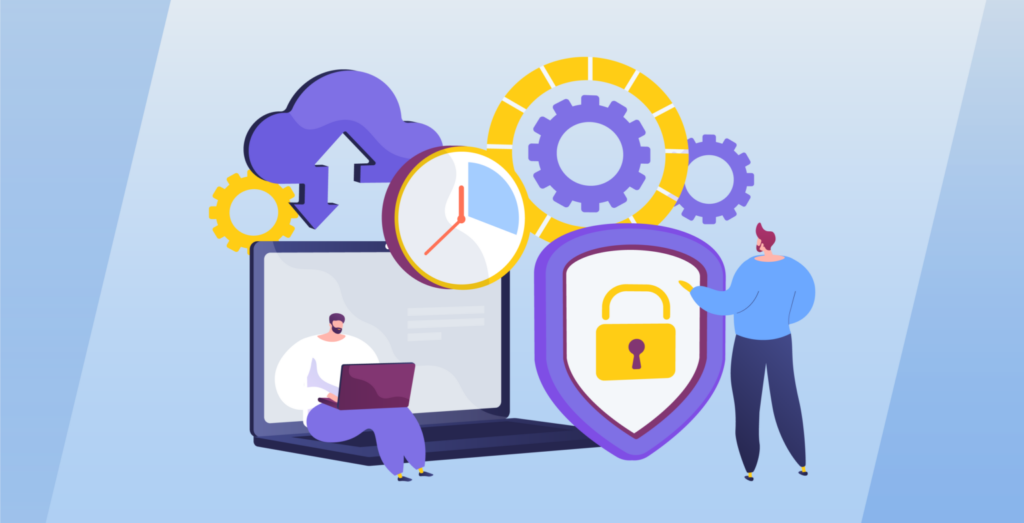Disaster Recovery – Your Head Should be “In-the-Cloud” introduces cloud-based solutions to restore mission-critical data. This article details the 7 Reasons and advantages your organization gains with a cloud backup and disaster recovery solution. Global Business Solutions, Inc. and Zimcom, our cloud-based service partner have jointly developed a cost-effective, time saving solution that protects your critical data.
Disaster Recovery is a set of tools and policies that helps restore mission-critical data, to ensure business continuity. Disruptions within your organization’s infrastructure will likely result in revenue and productivity loss. Therefore, because these systems form the foundation of all organizations today, implementing a disaster recovery solution is a must.
There are numerous disaster recovery scenarios, for instance, cold site, hot site, virtualization, datacenter DR, point-in-time copies, instant recovery, and more. Each scenario dictates a nuanced approach to solve each scenario. That is why most organizations are choosing cloud-based Backup and Disaster Recovery. These solutions deliver enterprise-grade functionality at a very reasonable price. Moreover, DRaaS (Disaster Recovery-as-a-Service) makes DR easy to manage.
Disaster Recovery-as-a-Service – What is it
Disaster Recovery as a Service is a cloud-based IT service offered by a managed solution providers like GBS. We ensure your data is securely backed up and stored in a remote data center which delivers true air-gap protection. With our DRaaS solution, our team ensures the replication of virtual servers to a remote site. These servers can then be deployed when needed. In essence, this means that an up-to-date copy of each protected server is present in the cloud. If your infrastructure ceases to function, recovery starts and concludes in minutes or hours, not days or weeks. The result – your organization continues its operations with data fully restored.
Since DRaaS leverages cloud-based resources, it results in high flexibility and scalability, as well as facilitated backup and DR process.
Disaster Recovery – The 7 Reasons Your Head Should be “In-the-Cloud”
1. Savings – $$$$ and Time
The main advantage of using DRaaS is undoubtedly cost savings. Should an organization decide to deploy a similar infrastructure by itself, it will inevitably face the need to purchase hardware capacities and software licenses for backup, and its network connectivity. At the same time, the load on the IT department will increase since the remote site will require administration. For companies with just a few business-critical applications running on a single host, deploying their own disaster recovery infrastructure will be too costly. By adding DRaaS, you gain the additional bandwidth, and can rest assured that your data is protected, and easily recoverable.
DRaaS eliminates the need for the following costs:
- Rental of premises for an auxiliary data center.
- Monthly maintenance costs: power supply, HVAC (intended for equipment cooling), Internet access.
- Purchase or lease of hardware: servers, storage, networking equipment.
- Employee salaries and their travel expenses for servicing the auxiliary data center.
2. Easy – Your Simple Button
Building and maintaining your own disaster recovery site can be both too complex and costly. The same holds true for configuration and testing backup and recovery processes, too. By getting rid of all of this infrastructure on your side and getting access to a dashboard that automates most of the functions and tools included in the DRaaS solution, you can forget about high administrative and maintenance requirements.
3. Quick Recovery & Frequent Backups
DRaaS automatically backs up data to the cloud with some degree of frequency and recovers the backup data in case of an emergency. Backup frequency and recovery speed are defined by RPO (recovery point objective) and RTO (recovery time objective) values accordingly. The lower these values, the higher your company’s IT resilience will be. On the other hand, you should be aware that close to zero RTO and RPO imply high cost, so you need to find optimal values by figuring out the potential monetary loss due to a system outage.
4. Data safety and security
With DRaaS, data is securely backed up and stored in a remote data center. This means that the data will be protected both against unexpected loss and from unauthorized access.
Cloud-based service providers employ highly reliable security protocols, sophisticated encryption, and timely security patches. These security protocols protect their data center with your data stored within. You’ll never be able to achieve this level of security if your data is stored on-premises. To make your data virtually invulnerable, cloud providers also use such approaches as private clouds and multi-factor authentication protocols.
5. Platform Agnostic
DRaaS solutions work with different systems, so you can, for instance, run virtual servers with different hypervisors and replicate data between various storage systems and clouds, which makes DRaaS hypervisor-, hardware-, and application-agnostic.
6. Accessibility
Since DRaaS is a cloud-based solution, your system will be accessible from any internet-connected location. In the event your physical office space is not able to be reached due to an emergency situation, remote servers can be managed from anywhere.
But still, DRaaS with its remote servers doesn’t mean you lose control of your IT infrastructure. On the contrary, you and your IT engineers team will still be able to manage applications and data storage, run and analyze reports, run backups, and recover lost data.
7. External IT expertise
As soon as you choose a DRaaS solution, you’ll get help and guidance from GBS, and Zimcom field experts whose primary expertise is data safety, cloud backup, and disaster recovery. Our team of professionals is here to resolve any issues quickly and with limited time investment from your IT staff.
DRaaS vs BaaS – A Difference of Scale, Deliverables & Timing
Backup-as-a-Service minimizes the negative impact of a data disaster. However, BaaS and DRaaS, are not the same. Simply put, BaaS protects data, while Disaster Recovery-as-a-Service protects applications, data and the entire infrastructure. BaaS is a subset of DRaaS with limited functionality. Additionally, the time to data availability differs greatly. With a GBS designed and executed DRaaS solution, RPO and RTO availability is within minutes. Whereas BaaS solutions typically take a day or multiple days to recover. The decision ultimately comes down to what your business needs dictate. Unlike BaaS, DRaaS has features that enable orchestration of failover, failback, and testing. And BaaS requires more manual interventions and, subsequently, more efforts and IT expertise from your in-house team members to work properly.
Want to speak with a cloud-based Disaster Recover expert – contact GBS Managed Services. Our team of cloud-certified technicians will work closely with you and our DRaaS partner, Zimcom, to establish key recovery objectives, and provide a no-cost estimate. The result – a cloud-based Disaster Recovery solution that ensures your organization’s ability to recover from any data disruption.
Contact GBS Managed Services – call 859.491.5900 or email aperkins@gbs-inc.com.


